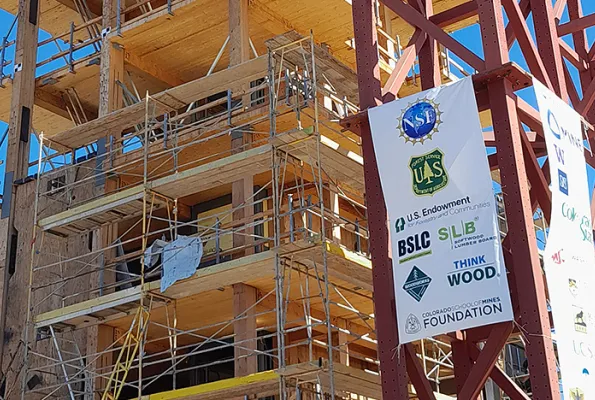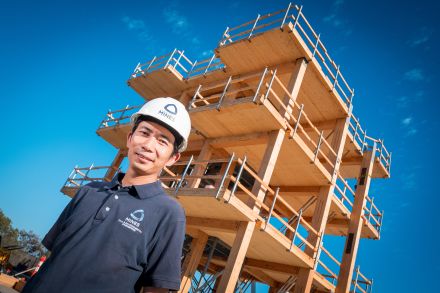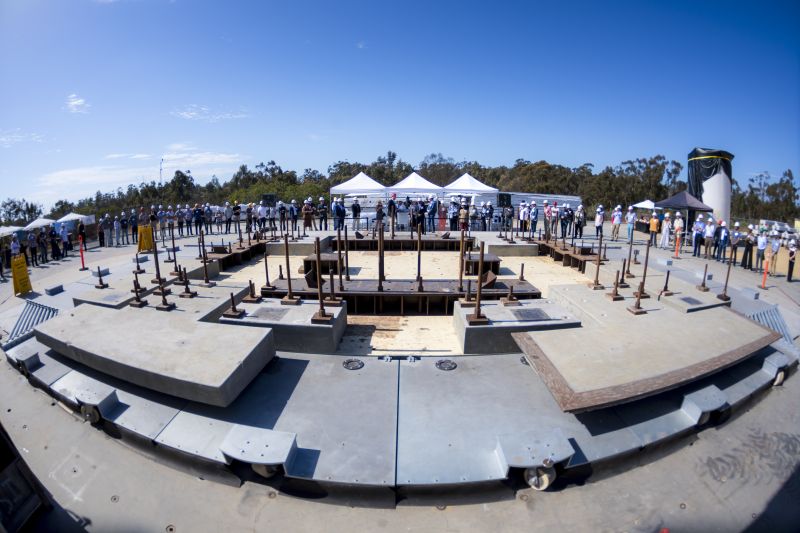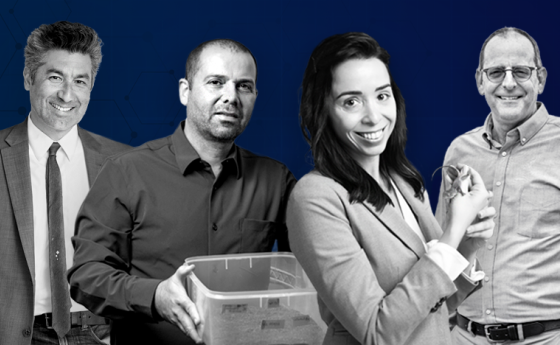
Earthquake tests could help wooden structures reach new heights
NSF-powered project designed to prove resilience of greener building material
Mass timber — a structural material engineered by bonding together layers of wood — is gaining popularity in the construction sector. Buildings constructed with the material can be erected more quickly and are more sustainable than those using traditional materials such as steel and concrete, which require large amounts of energy to produce.
As use of the new material increases, researchers and industry want to determine the performance of mass timber, especially in earthquake zones.
To help answer that question, a team of structural engineering researchers are subjecting a 10-story building constructed from mass timber to a series of tests. The building sits on top of a large movable platform, or shake table, which simulates the motion of earthquakes. By subjecting the building to a series of increasingly powerful tremors, engineers can evaluate the performance of building designs with mass timber during small seismic events and their ability to be repaired in the wake of larger earthquakes.
The Natural Hazards Engineering Research Infrastructure, or NHERI, TallWood project is simulating the earthquakes at the Large High Performance Outdoor Shake Table at the University of California, San Diego. Both the NHERI TallWood project and the shake table are funded by the U.S. National Science Foundation to advance the nation's infrastructure resilience.
A month of earthquakes
To create mass timber, small pieces of wood are glued together in layers to achieve a large volume structural wood members or panels that can be used as substitutes for traditional wood in building construction. The pieces can be used as beams, columns, floors, roofs and walls and the material has shown natural fire-resistance properties. Mass timber fits well with the growing interest in the use of sustainable building materials and modular construction and can be found in a growing number of single-family homes and buildings with just a few stories.
"As of 2022, there are over 1,700 buildings or projects being built or planned with mass timber in the U.S., from single story all the way to 27 stories," said Shiling Pei, the project's principal investigator and a civil engineer at Colorado School of Mines. "But there are not many mass timber lateral system options for the seismic zones. We know the existing lateral systems are safe, but if there is a huge earthquake, currently codified lateral systems are likely to experience permanent deformation, which means they would be very hard to repair."
In 2017, the NHERI TallWood project conducted tests on a two-story mass timber building, simulating shaking from the Northridge Earthquake, a magnitude 6.7 earthquake that struck Los Angeles in 1994. The building was subjected to 14 earthquake tests and remained structurally damage-free with no residual deformation.
With building codes in the U.S. now being revised to permit mass timber buildings of up to 18 stories, engineers hope to demonstrate the material's resilience to seismic activity. The project will test a complete building system made of mass timber to both measure the impact of an earthquake and show how repairs could be made quickly and easily so that the buildings do not have to be completely replaced after rare earthquakes.
The 10-story tall building being tested features a rocking wall lateral system, which consists of a solid wood wall panel anchored to the ground using steel cables or rods. The system is suitable for regions with high earthquake hazards. Tests will simulate earthquake motions recorded during prior events ranging from magnitude 4 to magnitude 8.
"Around 10 stories is the sweet spot for the TallWood building model. The code allows you to go to 18, but I think six to 12 is a good starting point and 10 stories is very representative for the demonstration," Pei said. Pei and his team are advocating to add this new lateral system into the U.S. seismic code following this test.
The project started in late April and, there are 40 planned tests. Along with the results of numerical models, Pei is optimistic about what these tests will show the industry and the public.
"Tests like this can really shatter the psychological ceiling for those thinking about building with wood. There is a lot of push in the building industry and local communities for net zero emission buildings, and people will see a lot of potential with mass timber construction. Building a structure proven to be earthquake-safe and built in a short time period can turn urban building infrastructure toward more green and efficient materials," he said.
NSF provides crucial support
NSF's impact can be seen — or felt — throughout this project.
Multiple universities are collaborating on the NHERI TallWood project, supported by $2 million in awards from NSF. The project also received support from U.S. Forest Service, Forest Products Laboratory and a number of industrial partners that helped with construction. The project also contributes to NSF's role in the National Earthquake Hazards Reduction Program, which is led by the National Institute for Standards and Technology and includes the Federal Emergency Management Agency and the United States Geological Survey.
The shake table, the world's largest outdoor experimental earthquake infrastructure facility, is just one part of NHERI, which provides researchers across the country with access to large, shared, state-of-the-art facilities to study the performance of innovative civil infrastructure designs and technologies under extreme natural conditions like those of earthquakes, tornadoes, hurricanes, tsunamis, and storm surge.
The shake table was recently upgraded thanks to NSF funding and is now able to reproduce the full 3D ground motions that occur during earthquakes, when the ground is moving in all six degrees of freedom — longitudinal, lateral, vertical, roll, pitch and yaw.






